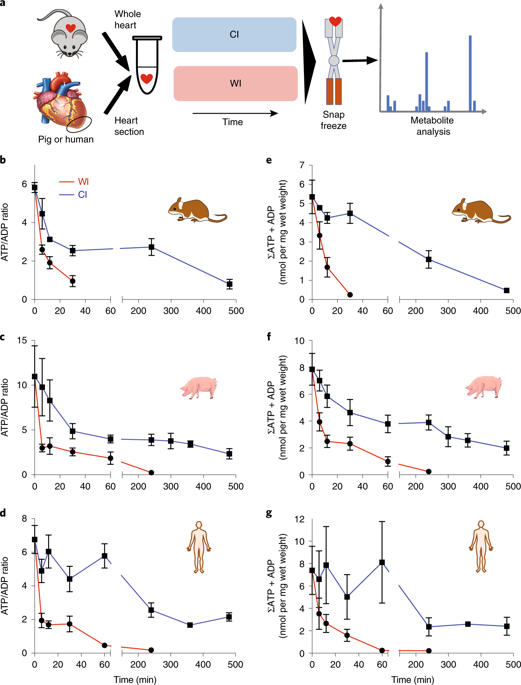当前位置:
X-MOL 学术
›
Nat. Metab.
›
论文详情
Our official English website, www.x-mol.net, welcomes your
feedback! (Note: you will need to create a separate account there.)
Succinate accumulation drives ischaemia-reperfusion injury during organ transplantation.
Nature Metabolism ( IF 18.9 ) Pub Date : 2019-09-30 , DOI: 10.1038/s42255-019-0115-y Jack L Martin 1 , Ana S H Costa 2 , Anja V Gruszczyk 1, 3 , Timothy E Beach 1 , Fay M Allen 3 , Hiran A Prag 3 , Elizabeth C Hinchy 3 , Krishnaa Mahbubani 1 , Mazin Hamed 1 , Laura Tronci 2 , Efterpi Nikitopoulou 2 , Andrew M James 3 , Thomas Krieg 4 , Alan J Robinson 3 , Margaret M Huang 1, 3 , Stuart T Caldwell 5 , Angela Logan 3 , Laura Pala 5 , Richard C Hartley 5 , Christian Frezza 2 , Kourosh Saeb-Parsy 1 , Michael P Murphy 3, 4
Nature Metabolism ( IF 18.9 ) Pub Date : 2019-09-30 , DOI: 10.1038/s42255-019-0115-y Jack L Martin 1 , Ana S H Costa 2 , Anja V Gruszczyk 1, 3 , Timothy E Beach 1 , Fay M Allen 3 , Hiran A Prag 3 , Elizabeth C Hinchy 3 , Krishnaa Mahbubani 1 , Mazin Hamed 1 , Laura Tronci 2 , Efterpi Nikitopoulou 2 , Andrew M James 3 , Thomas Krieg 4 , Alan J Robinson 3 , Margaret M Huang 1, 3 , Stuart T Caldwell 5 , Angela Logan 3 , Laura Pala 5 , Richard C Hartley 5 , Christian Frezza 2 , Kourosh Saeb-Parsy 1 , Michael P Murphy 3, 4
Affiliation

|
During heart transplantation, storage in cold preservation solution is thought to protect the organ by slowing metabolism; by providing osmotic support; and by minimising ischaemia-reperfusion (IR) injury upon transplantation into the recipient1,2. Despite its widespread use our understanding of the metabolic changes prevented by cold storage and how warm ischaemia leads to damage is surprisingly poor. Here, we compare the metabolic changes during warm ischaemia (WI) and cold ischaemia (CI) in hearts from mouse, pig, and human. We identify common metabolic alterations during WI and those affected by CI, thereby elucidating mechanisms underlying the benefits of CI, and how WI causes damage. Succinate accumulation is a major feature within ischaemic hearts across species, and CI slows succinate generation, thereby reducing tissue damage upon reperfusion caused by the production of mitochondrial reactive oxygen species (ROS)3,4. Importantly, the inevitable periods of WI during organ procurement lead to the accumulation of damaging levels of succinate during transplantation, despite cooling organs as rapidly as possible. This damage is ameliorated by metabolic inhibitors that prevent succinate accumulation and oxidation. Our findings suggest how WI and CI contribute to transplant outcome and indicate new therapies for improving the quality of transplanted organs.
中文翻译:

琥珀酸盐积累在器官移植过程中驱动缺血再灌注损伤。
在心脏移植过程中,保存在冷藏液中被认为可以通过减缓新陈代谢来保护器官;通过提供渗透支持;并通过在移植到受体 1、2 时最大限度地减少缺血再灌注 (IR) 损伤。尽管它被广泛使用,但我们对冷藏可防止的代谢变化以及热缺血如何导致损伤的了解却出奇地少。在这里,我们比较了小鼠、猪和人类心脏在热缺血 (WI) 和冷缺血 (CI) 期间的代谢变化。我们确定了 WI 期间常见的代谢改变和受 CI 影响的代谢改变,从而阐明了 CI 益处的潜在机制,以及 WI 如何造成损害。琥珀酸积累是跨物种缺血心脏的主要特征,CI 减缓琥珀酸生成,从而减少由线粒体活性氧 (ROS) 的产生引起的再灌注组织损伤 3,4。重要的是,器官获取过程中不可避免的 WI 期会导致移植过程中破坏性琥珀酸盐水平的积累,尽管尽可能快地冷却器官。这种损害可通过防止琥珀酸积累和氧化的代谢抑制剂得到改善。我们的研究结果表明 WI 和 CI 如何影响移植结果,并指出用于提高移植器官质量的新疗法。这种损害可通过防止琥珀酸积累和氧化的代谢抑制剂得到改善。我们的研究结果表明 WI 和 CI 如何影响移植结果,并指出用于提高移植器官质量的新疗法。这种损害可通过防止琥珀酸积累和氧化的代谢抑制剂得到改善。我们的研究结果表明 WI 和 CI 如何影响移植结果,并指出用于提高移植器官质量的新疗法。
更新日期:2019-09-30
中文翻译:

琥珀酸盐积累在器官移植过程中驱动缺血再灌注损伤。
在心脏移植过程中,保存在冷藏液中被认为可以通过减缓新陈代谢来保护器官;通过提供渗透支持;并通过在移植到受体 1、2 时最大限度地减少缺血再灌注 (IR) 损伤。尽管它被广泛使用,但我们对冷藏可防止的代谢变化以及热缺血如何导致损伤的了解却出奇地少。在这里,我们比较了小鼠、猪和人类心脏在热缺血 (WI) 和冷缺血 (CI) 期间的代谢变化。我们确定了 WI 期间常见的代谢改变和受 CI 影响的代谢改变,从而阐明了 CI 益处的潜在机制,以及 WI 如何造成损害。琥珀酸积累是跨物种缺血心脏的主要特征,CI 减缓琥珀酸生成,从而减少由线粒体活性氧 (ROS) 的产生引起的再灌注组织损伤 3,4。重要的是,器官获取过程中不可避免的 WI 期会导致移植过程中破坏性琥珀酸盐水平的积累,尽管尽可能快地冷却器官。这种损害可通过防止琥珀酸积累和氧化的代谢抑制剂得到改善。我们的研究结果表明 WI 和 CI 如何影响移植结果,并指出用于提高移植器官质量的新疗法。这种损害可通过防止琥珀酸积累和氧化的代谢抑制剂得到改善。我们的研究结果表明 WI 和 CI 如何影响移植结果,并指出用于提高移植器官质量的新疗法。这种损害可通过防止琥珀酸积累和氧化的代谢抑制剂得到改善。我们的研究结果表明 WI 和 CI 如何影响移植结果,并指出用于提高移植器官质量的新疗法。











































 京公网安备 11010802027423号
京公网安备 11010802027423号